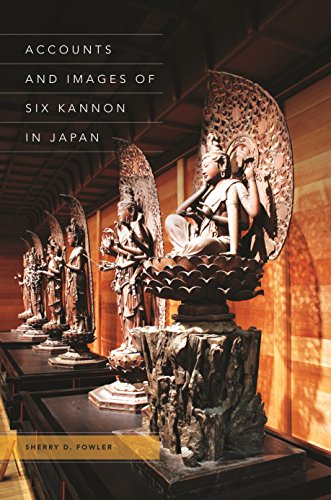
By Sherry D. Fowler
Buddhists all over the world have fun the advantages of worshipping Kannon (Avalokiteśvara), a compassionate savior who's some of the most loved within the Buddhist pantheon. while Kannon seems in a number of manifestations, the deity’s powers are believed to extend to even larger heights. this idea generated a number of cults all through heritage: one of the most vital is the cult of the Six Kannon, which started in Japan within the 10th century and remained well-liked during the 16th century. during this bold paintings, Sherry Fowler examines the advance of the japanese Six Kannon cult, its sculptures and work, and its transition to the Thirty-three Kannon cult, which is still lively to this day.
An exemplar of Six Kannon imagery is the whole set of life-size wood sculptures made in 1224 and housed on the Kyoto temple Daihōonji. This set, besides others, is analyzed to illustrate how Six Kannon worship impacted Buddhist perform. applying a diachronic strategy, Fowler provides case reports starting within the 11th century to reinstate a context for units of Six Kannon, nearly all of which were misplaced or scattered, and therefore illuminates the vibrancy, significance, and distribution of the cult and complements our wisdom of spiritual image-making in Japan.
Kannon’s function in aiding beings trapped within the six paths of transmigration is a well-documented catalyst for the choice of the quantity six, yet there are different major subject matters at paintings. Six Kannon worship contains major foci on worldly issues reminiscent of childbirth and animal husbandry, ties among textual content and photo, and various correlations with Shinto kami teams of six. whereas making teams of Kannon noticeable, Fowler explores the fluidity of numerical deity categorizations and the makes an attempt to quantify the invisible. furthermore, her research finds Kyushu as a particularly energetic web site within the background of the Six Kannon cult. a lot as Kannon pictures as soon as functioned to draw worshippers, their presentation during this ebook will attract modern readers to revisit their assumptions approximately East Asia’s hottest Buddhist deity.
Read Online or Download Accounts and Images of Six Kannon in Japan PDF
Best buddhism books
Alan Cole's Text as Father: Paternal Seductions in Early Mahayana PDF
This superbly written paintings sheds new mild at the origins and nature of Mahayana Buddhism with shut readings of 4 famous texts—the Lotus Sutra, Diamond Sutra, Tathagatagarbha Sutra, and Vimalakirtinirdesa. Treating those sutras as literary works instead of as common philosophic or doctrinal treatises, Alan Cole argues that those writings have been conscientiously sculpted to undermine conventional monastic Buddhism and to realize legitimacy and authority for Mahayana Buddhism because it used to be veering clear of Buddhism’s older oral and institutional types.
Read e-book online Sagesse des contes Bouddhistes: Exercices philosophiques PDF
Chacune des grandes religions est porteuse de sagesse. C'est le element de départ de cette assortment qui suggest 20 méditations pour penser sa vie et donner du sens à son lifestyles. Faut-il chercher à tout savoir ? Sommes-nous responsable de ce qui nous arrive ? Peut-on maîtriser ses émotions ? Doit-on souffrir pour se réaliser ?
Get Signs from the Unseen Realm: Buddhist Miracle Tales from PDF
In early medieval China 1000s of Buddhist miracle texts have been circulated, inaugurating a development that might proceed for hundreds of years. every one story mentioned outstanding occasions related to chinese language individuals and places—events obvious as verifying claims made in Buddhist scriptures, demonstrating the truth of karmic retribution, or confirming the efficacy of Buddhist devotional practices.
Download e-book for iPad: Patrons and Patriarchs: Regional Rulers and Chan Monks by Benjamin Brose
Consumers and Patriarchs breaks new flooring within the examine of clergy-court family members through the tumultuous interval that spanned the cave in of the Tang dynasty (618–907) and the consolidation of the Northern music (960–1127). this period, referred to as the 5 Dynasties and Ten Kingdoms, has usually been characterised as a time of debilitating violence and instability, however it additionally introduced elevated monetary prosperity, neighborhood improvement, and political autonomy to southern territories.
- Heart of the Great Perfection: Dudjom Lingpa's Visions of the Great Perfection
- How to Gain Nothing from Buddhist Practice: A Practitioner's Guide to End Suffering.
- The Yeshe Lama: Jigme Lingpa's Dzogchen Atiyoga Manual
- The Teeth and Claws of the Buddha: Monastic Warriors and Sohei in Japanese History
- The Taboo of Subjectivity: Towards a New Science of Consciousness
Additional resources for Accounts and Images of Six Kannon in Japan
Example text
Accounts and Images of Six Kannon in Japan by Sherry D. Fowler
by John
4.2



